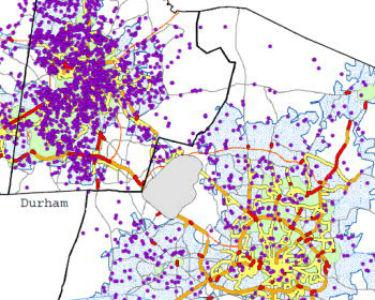
Several DMPI investigators including Simon Gregory, Beth Hauser, Bill Kraus, Svati Shah, Colette Blach, Elaine Dowdy, and Carol Haynes, were honored with a rarely awarded Level I Scientific and Technical Achievement Award (STAA) from the Environmental Protection Agency for a series of studies conducted with a former graduate student, Cavin Ward-Caviness. Cavin is now a Principal Investigator with the EPA in Chapel Hill. Their research “Demonstrating the effects of air pollution on individuals with prior cardiac complications” found a link between traffic-related air pollution and cardiovascular disease.
The Level I STAA is the EPA’s scientific Oscar. This program promotes and recognizes scientific and technological achievement and is among the most prestigious of the EPA's scientific award programs. As described on the EPA website, Level 1 awards are for those who have accomplished an exceptionally high-quality research or technological effort. The awards recognize the creation or general revision of scientific or technological principle or procedure, or a highly significant improvement in the value of a device, activity, program, or service to the public. Awarded research is of national significance or has high impact on a broad area of science/technology. The research has far reaching consequences and is recognizable as a major scientific/technological achievement within its discipline or field of study.
This research was the culmination of Cavin’s dissertation.
Publications:
- Gene-smoking interactions in multiple Rho-GTPase pathway genes in an early-onset coronary artery disease cohort
- Associations Between Residential Proximity to Traffic and Vascular Disease in a Cardiac Catheterization Cohort
- Association of Roadway Proximity with Fasting Plasma Glucose and Metabolic Risk Factors for Cardiovascular Disease in a Cross-Sectional Study of Cardiac Catheterization Patients
- Genetic Variants in the Bone Morphogenic Protein Gene Family Modify the Association between Residential Exposure to Traffic and Peripheral Arterial Disease
- A genome-wide trans-ethnic interaction study links the PIGR-FCAMR locus to coronary atherosclerosis via interactions between genetic variants and residential exposure to traffic
